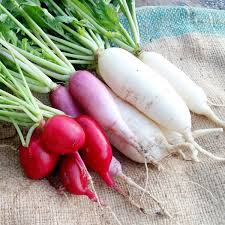Radishes are one of the easiest vegetables to grow. Although they are very easy to grow, we encounter some common problems while growing radishes. In this section, we will see about growing radishes right from the seeds and the various tips to grow radish like a gardening pro. In addition, we will also see about the companion plants that can be grown along with radish in our home garden.
The first thing that we will see is how to start radish plants from seeds.
* Soil for growing radishes must be loose and adding compost, dried leaves and grass will improve soil fertility. The soil must also be consistently moist for the good growth of roots. Drought or dry conditions will make the growth of radish tough due to soil crusting and will also alter the flavour.
* The seeds must be spaced half-inch deep and one inch apart.
* Optimal growth of radish requires full sun and light shade is toleratable at times.
* Radish mature quickly and will be ready to harvest within 4 to 5 weeks.
Let's see few tips for better growth of radish:
1. Practice succession planting by sowing radish seeds every 7 to 10 days, for continual harvest.
2. When the soil becomes crusty, break it and loosen it by adding some water.
3. Several radish varieties can be planted together for enhanced growth of radishes.
4. A tip to know the maturity of the radish roots is to look out for the bulged tops that push themselves out of the soil as they near maturity.
5. For radishes with their best taste and flavor, harvest them immediately after they mature, because the longer they stay in the ground, the hotter they become.
Moving onto the next segment, which is fertilizing radishes.
Before you plant the seeds, fertilize the top 2 to 4 inches of the soil with all purpose fertilizer and sow the seeds half an inch deep.
If you would like to avoid commerical fertilizer add some compost on the top layer.
The initial fertilizer application is enough for the growth is radishes, but if you would like to enhance the growth, you can go for an addition of nitrogen rich fertilizer in the quantity of 1/4 cup for every ten foot. If you are one who loves to consume the radish foliage also, then this fertilizing option is for you.
Now, the most important, point is companion planting for radish.
The first factor to consider for companion planting is the time of maturity of the plants.
Radish is a rapidly maturing plant and so, we can consider co-planting radish with other plants that take up a slower maturity time. For instance, peas, leaf lettuces, tomatoes and peppers, are plants that take more time to mature and so can be grown along with radish.
The second factor is the co-planting of plants that can benefit from radish.
Radishes will greatly help to repel cucumber beetles and hence planting cucumber along with radish will increase the yield of both the plants.
The third factor is planting of plants that will help radish plants.
Strong smelling herbs such as nasturtium and plants such as onions are excellent companions for radish plants.
Some plants that should not be planted along with radish are broccoli and hyssop.
Last tip is that, radishes can also be planted together with flowers and herbs, along the borders of the garden or gardening beds as the rich foliage gives an attractive look along with flowers.





















